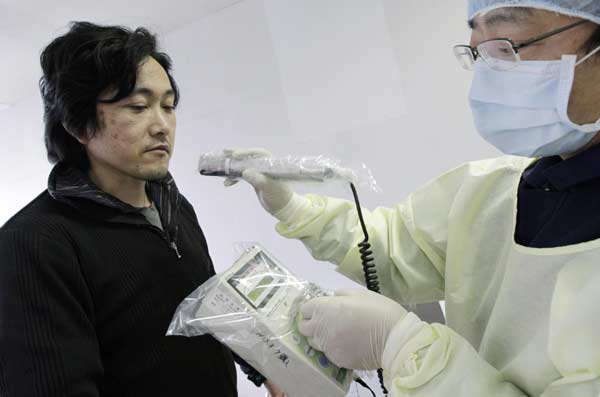Asia
Pressure rises again in Japan reactor
Updated: 2011-03-20 13:32
(Agencies)
FUKUSHIMA, Japan - Technicians prepared to vent radioactive gas into the air Sunday because of a new spike in pressure at Japan's crippled, leaking nuclear complex, while a safety official said protective iodine pills should have been distributed near the plant days earlier.
 Isao Saito, who evacuated from Iwaki, Fukushima, receives a screening test for nuclear radiation at a welfare center in Yamagata, northern Japan March 20, 2011, nine days after Japan's devastating earthquake and tsunami. [Photo/Agencies] |
| ||||
Radiation, a danger for days in areas around the plant, already has seeped into the food supply, with the government warning that tests of spinach and milk from areas as far as 75 miles (120 kilometers) away exceeded safety limts. Tap water farther away turned up tiny amounts of radioactive iodine in Tokyo and other areas.
Amid concerns of wider contamination, a nuclear safety official said the government was caught off-guard by the accident's severity and only belatedly realized the need to give potassium iodide to those living within 12 miles (20 kilometers) of the Fukushima Dai-ichi nuclear complex.
The pills help reduce the chances of thyroid cancer, one of the diseases that may develop from radiation exposure. The official, Kazuma Yokota, said an explosion at the plant's Unit 3 reactor last Sunday should have triggered the distribution. But the order only came three days later.
"We should have made this decision and announced it sooner," Yokota told reporters at the emergency command center in the city of Fukushima. "It is true that we had not foreseen a disaster of these proportions. We had not practiced or trained for something this bad. We must admit that we were not fully prepared."
While four of Fukushima's six nuclear reactors have been dangerously overheating since the March 11 earthquake and tsunami disrupted cooling systems, Unit 3 has proved particularly troublesome.
After the government said Saturday that the unit appeared to be stabilizing after being doused with water, nuclear safety officials said the efforts may not have worked. Pressure was rising again inside the reactor's containment vessel, requiring a release of radioactive gas to prevent a more dangerous buildup, said safety agency official Hidehiko Nishiyama.
The venting is an "unavoidable measure to protect the containment vessel," Nishiyama said. He warned that a larger amount of radiation would have to be released than when similar venting was done a week ago because more nuclear fuel have have degraded since then.
While battling Unit 3, emergency teams used an unmanned vehicle to spray water at another at-risk reactor - Unit 4 - while preparing to switch power back on for the first time since a March 11 earthquake and tsunami knocked out the plant's crucial cooling systems.
However, there was no guarantee the cooling systems would still work, even once power was restored.
E-paper

City of Joy
Welcome to the 'world of smiles' where life meanders slowly.
Debate on nuclear power revived
The future is now
Common approach
Specials

Earthquake Hits Japan
A massive 8.8 magnitude quake hit the northeast coast of Japan on March 11,2011.

NPC & CPPCC sessions
Lawmakers and political advisers gather in Beijing to discuss major issues.

Slide: Japan quake
Devastating earthquake and tsunami left millions without water, electricity, homes or heat.



